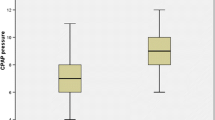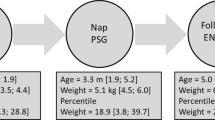Abstract
To investigate the role of awake upper airways (UA) endoscopy assessment as a parameter of prediction for CPAP titration in OSAHS patient therapy. Retrospective analysis of UA endoscopic assessment with Mueller’s maneuvre and the application of the nose oropharynx hypopharynx score (NOHs) was conducted to obtain a numeric score representing the grade of severity of UA obstruction. Other commonly used predictive parameters for CPAP titration were also included in the study: anthropometric [BMI, neck circumference (NC)] and polysomnographic parameters (AHI, ODI). 3 groups of patients were identified: (1) 67/90 patients requiring intermediate CPAP values, (2) 13/90 patients requiring high CPAP values, and (3) 10/90 patients requiring low pressure values. BMI (p = 0.0013) was the only monitored parameter to show significant statistical value as a CPAP titration predictor. However, higher values of anthropometric parameters (NOHs ≥9, BMI >35, NC >45) showed a sensitivity of 69.2 % as a single parameter and 76.9 % as combined parameters, and specificity between 66.2 and 72.7 % as a single parameter and 43.4 % as combined parameters, unequivocally identifying patients requiring high therapeutic CPAP value. A lower cut-off of anthropometric parameters (NOHs ≤6, BMI ≤29, NC <42) showed sensitivity between 40 and 60 % as a single parameter and of 90 % as combined parameters, and specificity between 68.7 and 80.2 % as a single parameter which increased to 93.7 % as combined parameters, identifying patients requiring a low therapeutic CPAP value. The results show that anthropometric and polygraphic parameters have no significant independent predictive value for CPAP titration, with the exception of BMI. However, anthropometric parameters showed good levels of sensitivity and specificity in OSAHS patients requiring high or low levels of CPAP therapy.
Similar content being viewed by others
References
Mwenge GB, Rodenstein D (2010) Public health and legal implication of OSA, chapter 13. European Respiratory Society Monograph 50(Sleep Apnoea):216–224
Marin J, Carrizzo S, Vincente E, Agusti A (2005) Long-term cardiovascular outcomes in men with obstructive sleep apnea–hypopnea with or without treatment with continuous positive airway pressure: an observational study. Lancet 365:1046–1053
Schellemberg J, Maislin G, Schwab R (2000) Physical findings and risk for obstructive sleep apnea. Am J Respir Crit Care Med 162:740–748
Skjodt N (2008) Approach to outpatient management of adult sleep apnea. Can Fam Phiysician 54:1408–1412
Tsai W, Remmers J, Brant R, Flemons W, Davies J, Macartur C (2003) A decision rule for diagnostic testing in obstructive sleep apnea. Am J Respir Crit Care Med 167:1427–1432
Kroker B, Olson L, Saunders N, Hensley M, McKeon J, Allen K, Gyulay S (1990) Estimation of the probability of disturbed breathing during sleep before a sleep study. Am J Respir Crit Care Med 142:14–18
Flemons W, Whitelaw W, Brant R, Remmers J (1994) Likelihood ratios for a sleep apnea clinical prediction rule. Am J Respir Crit Care Med 150:1279–1285
Rowley J, Aboussouan L, Badr M (2000) The use of clinical prediction formulas in the evaluation of obstructive sleep apnea. Sleep 23(7):929–938
Harding S (2001) Prediction formulae for sleep-disordered breathing. Curr Opin Pulm Med 7(6):381–385
Stuck B, Mauer J (2008) Airways evaluation in obstructive sleep apnea. Sleep Med Rev 12:411–436
Terris D, Hanosono M, Liu Y (2000) Reliability of Muller maneuver and its association with sleep-disordered breathing. Laryngoscope 110:1819–1823
Dreher A, de la Chaux R, Klemens C, Werner R, Baker F, Barthlen G, Rasp G (2005) Correlation between otorhinolaryngologic evaluation and severity of obstructive sleep apnea syndrome in snorers. Arch Otolaryngol Head Neck Surg 131:95–98
Santaolalla Montoya F, Iriondo Bedialauneta J, Aguirre Larracoechea U, Martinez Ibarguen A, Sanchez Del Rey A, Sanchez Fernandez J (2007) The predictive value of clinical and epidemiological parameters in the identification of patients with obstructive sleep apnoea (OSA): a clinical prediction algorithm in the evaluation of OSA. Eur Arch Otorhinolaryngol 264(6):637–643
Hoffstein V, Mateika S (1994) Predicting nasal continuous positive airway pressure. Am J Respir Crit Care Med 150:486–488
Series F (2000) Accuracy of an unattended home CPAP titration in the treatment of obstructive sleep apnea. Am J Respir Crit Care Med 162:94–97
Ferini-Strambi L, Manni R, Marrone O, Mondini S, Spaggiari C, Braghiroli A, Sanna A, Vianello A (2001) Linee guida di procedura diagnostica nella sindrome delle apnee ostruttive nel sonno dell’adulto. Commissione paritetica AIPO-AIMS. Rassegna di Patologia Apparato Respiratorio 16:261–272
Collop NA, Mc Dowell Anderson W, Boehlecke B, Claman D, Goldberg R, Gotlieb D, Hudgel D, Sateia M, Schwab R (2007) Clinical guidelines for use of unattended portable monitors in the diagnosis of obstructive sleep apnea in adult patients. Portable Monitoring Task Force of American Academy of Sleep Medicine. J Clin Sleep Med 3(7):737–747
Patruno V, Bosi M, Sanna A, Fanfulla F, Graghiroli A, Insalaco G (2006) Gli indici per la diagnosi strumentale delle apnee ostruttive nel sonno: standardizzazione del calcolo con polisonnografia e monitoraggio cardiorespiratorio. Rassegna di Patologia Apparato Respiratorio 21:22–27
The AASM Manual for the Scoring of Sleep and Associated Events (2007) Rules, terminology and technical specifications. American Academy of Sleep Medicine, Westchester
Vicini C, De Vito A, Benazzo M, Frassineti S, Frasconi P, Mira E (2012) The nose oropharynx hypopharynx and larynx (NOHL) classification: a new system of diagnostic standardized examination for OSAHS patients. Eur Arch Otorhinolaryngol 269(4):1297–1300
Insalaco G, Sanna A, Fanfulla F, Patruno V, Braghiroli A, Marrone O (2005) La terapia con dispositivo a pressione positiva nelle vie aeree: raccomandazioni per la prescrizione nel soggetto adulto affetto dalla sindrome con apnee ostruttive nel sonno. Documento AIPO a cura del Gruppo di Studio “Disturbi respiratori nel sonno”. Rassegna di Patologia Apparato Respiratorio 20:60–63
Morgenthaler TI, Aurora RN, Brown T, Zak R, Alessi C, Boehlcke B, Friedman L, Kapur V, Maganti R, Owens J, Pancer J, Swick TJ (2008) Practice parameters for the use of auto-titrating continuous positive airway pressure devices for titrating pressures and treating adult patients with obstructive sleep apnea syndrome: an update for 2007. Sleep 31(1):141–147
Gervilla M, Jacomelli M, Figueiredo A, Cahali M, Pedreira W, Lorenzi Filho G (2007) Evaluation of airway obstruction by nasopharyngoscopy: comparison of the Muller maneuver versus induced sleep. Rev Bras Otorhinolarygnol 73(5):618–622
De Vito A, Agnoletti V, Berrettini S, Piraccini E, Criscuolo A, Corso R, Campanini A, Gambale G, Vicini C (2011) Drug-induced sleep endoscopy: conventional versus target controlled infusion techniques. A randomized controlled study. Eur Arch Otorhinolaryngol 268:457–462
Bachar G, Feinmesser R, Shpitzer T, Yaniv E, Nageris B, Eidelman L (2008) Laryngeal and hypopharyngeal obstruction in sleep disordered breathing patients, evaluated by sleep endoscopy. Eur Arch Otorhinolaryngol 265(11):1397–1402
Kushida CA, Chediak A, Berry RB, Brown LK, Gozal D, Iber C, Parthasarathy S, Quan SF, Rowley JA (2008) Clinical guidelines for the manual titration of positive airway pressure in patients with obstructive sleep apnea. J Clin Sleep Med 4(2):157–171
Dempsey J, Veasey S, Morgan B, O’Donnell C (2010) Pathophysiology of sleep apnea. Physiol Rev 90:47–112
Younes M (2004) Role of arousals in the pathogenesis of obstructive sleep apnea. Am J Respir Crit Care Med 169:623–633
Longobardo S, Evangelisti C, Cherniack N (2009) Influence of arousal threshold and depth of sleep on respiratory stability in man: analysis using a mathematical model. Exp Physiol 94:1185–1199
Wellman A, Jordan A, Malhotra A, Fogel R, Katz E, Schory K, Edwards J, White D (2004) Ventilatory control and airway anatomy in obstructive sleep apnea. Am J Respir Crit Care Med 170:1225–1232
Conflict of interest
None.
Author information
Authors and Affiliations
Corresponding author
Rights and permissions
About this article
Cite this article
Bosi, M., De Vito, A., Vicini, C. et al. The predictive value of Muller’s maneuvre for CPAP titration in OSAHS patients. Eur Arch Otorhinolaryngol 270, 2345–2351 (2013). https://doi.org/10.1007/s00405-013-2412-5
Received:
Accepted:
Published:
Issue Date:
DOI: https://doi.org/10.1007/s00405-013-2412-5




